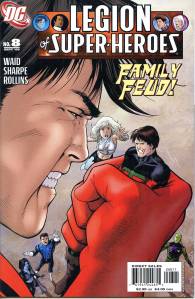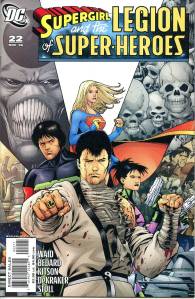Kara Zor-El has seen some epic adventures over the years, but finds her life without meaning or purpose. Here she is, a young woman who saw her planet destroyed and was sent to Earth to protect a baby cousin who ended up not needing her. What was it all for? Wherever she goes, people only see her through the lens of Superman’s fame. Just when Supergirl thinks she’s had enough, everything changes. An alien girl seeks her out for a vicious mission. Her world has been destroyed, and the bad guys responsible are still out there. She wants revenge, and if Supergirl doesn’t help her, she’ll do it herself, whatever the cost. Now a Kryptonian, a dog, and an angry, heartbroken child head out into space on a journey that will shake them to their very core.
Tag: Supergirl
Supergirl V7 (2016)
The 2016 DC Comics title relaunch Rebirth incorporates several elements (such as the costume, the setting and some characters) from the Supergirl television series. The DC Rebirth initiative undid the New 52’s modern recreations, bringing DC’s heroes back to their more classic iterations. Supergirl’s new series (Volume 7) was titled Supergirl: Rebirth, written by Steven Orlando. The first arc was pencilled by Brian Ching, who also redesigned Supergirl’s costume in reference to a more classic look.
Supergirl V2 (1982)
Supergirl (Volume 2) was published from November of 1982 until September of 1984, spanning a total of 23 issues. The series was initially entitled, the Daring New Adventures of Supergirl, but shortened the title to simply, Supergirl, with issue #13. This was the last regular comic series to feature the Pre-Crisis Kara Zor-El as Supergirl.
Legion of Super-Heroes V5 (2005)
Initial issues of this volume reintroduced the characters, and provided new and divergent origins for them. Most characters resemble their previous counterparts in costume and powers, with the most notable exceptions including Chameleon Boy, now called simply Chameleon and depicted as an androgynous creature; Star Boy, who in this version of the Legion is black; Colossal Boy, who is now a giant who shrinks to human size; and Phantom Girl, who exists in two universes at once and has conversations with people in her own dimension while talking to Legionnaires at the same time.
Beginning with issue #16, The Legion of Super-Heroes (vol. 5) was retitled Supergirl and the Legion of Super-Heroes with Supergirl traveling to the future and joining the Legion. With issue #31, Tony Bedard replaced Waid as writer. The title reverted to The Legion of Super-Heroes with issue #37 and Jim Shooter became the writer. The series ended with issue #50, in which the script was credited to “Justin Thyme”, a pseudonym previously used by uncredited comic book artists.
Supergirl V5 (2005)
After the launch of the Superman/Batman comic book series, Executive Editor Dan DiDio had been looking for a way to simplify the Supergirl character from her convoluted post-crisis history; the simplest version of course, was Superman’s cousin. Jeph Loeb and editor Eddie Berganza found an opening to reintroduce the character following the conclusion of the first story arc of Superman/Batman.
The modern version of Kara Zor-El made her debut in Superman/Batman #8 (2004). Kara takes the mantle of Supergirl at the conclusion of the storyline. The Supergirl comic book series would later be relaunched, now starring Kara Zor-El as “The Girl of Steel”. The first arc of the new series was written by Jeph Loeb and illustrated by Ian Churchill.
Supergirl V1 (1972)
Supergirl starred in her first solo eponymous monthly series beginning in 1972 until October 1974, when her monthly title merged with Superman’s Girl Friend, Lois Lane, and Superman’s Pal Jimmy Olsen to produce a new title: then-highest DC selling series called The Superman Family, where she eventually became the steady lead story. Linda worked as a student advisor at New Athens Experimental School, before leaving for New York to follow a career in acting with daytime soap Secret Hearts.
Supergirl V4 (1996)
Beginning in September 1996, DC published Supergirl (vol. 4) written by Peter David. The 1996 Supergirl comic book revamped the previous Matrix Supergirl by merging her with a human being, resulting in a new Supergirl. Many elements of the Pre-Crisis Supergirl were incorporated in new ways. The woman that the Matrix merges with has the same name as the Pre-Crisis Supergirl’s secret identity, Linda Danvers. The series is set in the town of Leesburg, named after Danvers’ pre-adoption surname. Linda’s father is named Fred Danvers, the same as the Pre-Crisis Supergirl’s adopted father. Furthermore, new versions of Dick Malverne and Comet appear as part of the supporting cast.
As the series begins, the Matrix sacrifices herself to save a dying Linda Danvers and their bodies, minds and souls merge to become an “Earth-Born Angel“, a being created when one being selflessly sacrifices him or herself to save another who is beyond saving. As the angel, Supergirl loses some of her powers, but gains others, including fiery angel wings and a “shunt” ability that allows her to teleport to any place she has been before.




















